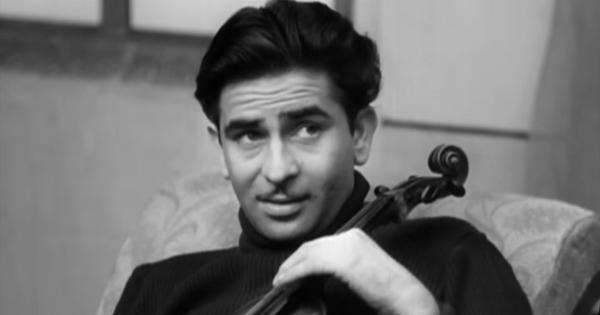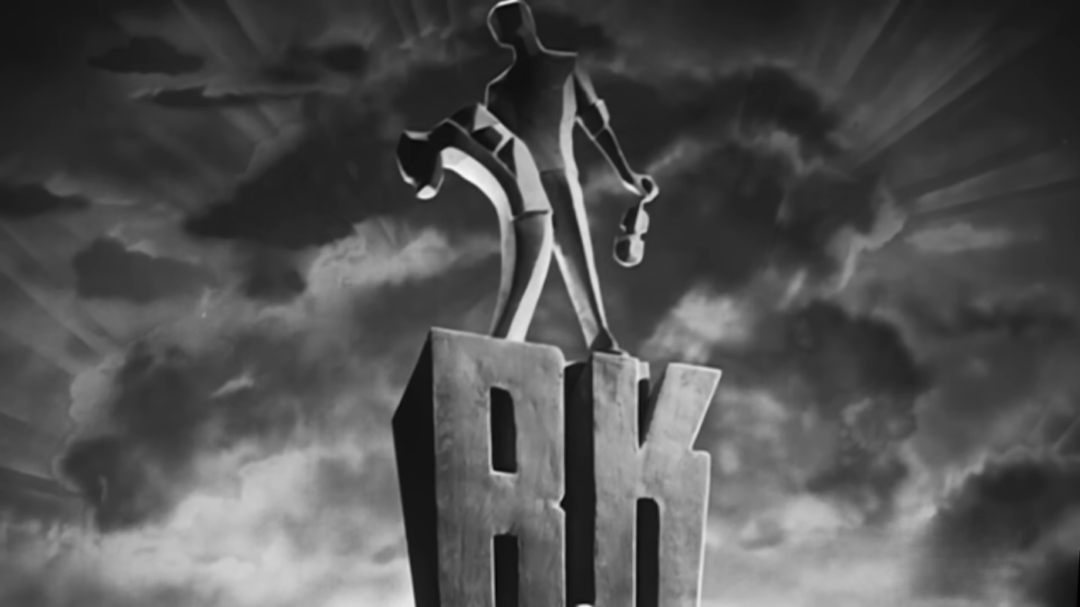
Aag was not particularly commercially successful and what made Raj Kapoor famous was his next production, Barsaat (Rain, 1949). However, it is in Aag that we see experimentation with a visual lexicon that communicates the protagonist’s seething passion.
In many films that Kapoor made after this, the image tends to settle into serving the storyline (either of thwarted or realised passion) and we see less of the deliberate and intuitive play of visual lyricism. Innovative visual lyricism paves way for the plot (in Aag) rather than the other way round in his later films. The displaced proscenium arch, however, recurs in Barsaat, especially in the pillars and frames of the lake-house on stilts that the protagonist rents in idyllic Kashmir.
In Barsaat, Raj Kapoor takes on the persona of Pran, a young man from the city, and his lady love is again played by Nargis – she is the daughter of the caretaker of the house. This structure is a studio space designed to replicate the monumentality and verticality of a theatre set with its two levels, a distinct (watery) foreground, clear entry/exit points for the character as well as constant ascent and descent. The protagonist is often shown playing his beloved violin on the balcony of this house that again evokes a theatrical balcony, while the ornate tall pillars, gently sloping roof and low wooden banisters in the foreground invite us into a proscenium space. Most of the significant meetings between the lovers happen here – it functions almost as a Shakespearean balcony where lovers divided by class and family find temporary reprieve and solace.
In a highly sexualised scene where his lover steals to him in the middle of the night drawn by the crescendos and diminuendos of the tides of his music, Pran’s violin is knocked out of his hands as she rushes to take its place. The proscenium arch is breached as the camera moves close to the lovers. Her body twists, turns and writhes in an absolute entanglement of bodies.
The shots are from the top angle (the fiddle appearing phallic). He says that he wants to play her like a violin till she quivers from head to toe (‘Ji chahata hai tumhare dil ke taaron ko is tarah ched doon ke bas sar se paavn tak jhanjhana utho’). She confesses that such has already happened but he has not heard its sound. He indicates that playing the violin has become an outlet for his (unmet) sexual needs, his fingers bloodied from so much playing. She puts her open lips to his fingers as the sexual tension continues to rise.
This scene had started with the full-frontal proscenium framing of the balcony setting. But after the loss of the violin and the close proximity of bodies, the scene sculpts new emotive sites (the close up of lip on finger, distorted angles of vision) for the camera to enter and occupy. The shift from the proscenium to the cinematic is indexed by the viewer’s new intimacy with the sexual – the eye can travel in cinema in a manner that generates a new oeuvre of sexual imagery.
Till this scene of man-woman-balcony-violin, we were only offered the purity of the woman’s sexual passion – there had been no backstory, only a threadbare parental commentary (for her, not for him). Indeed, neither of them gave any rationale for their love beyond their submergence in the moment and the representation of passion and sexual love in a ‘frozen’ image in this 1949 film is unique in Indian cinema.
That Raj Kapoor – who has been seen as trying ‘to purvey the image of the one-man industry’ – was aware of the import of this moment can be assumed from his choosing to make an icon of this moment to represent his production house R.K. Films. The real life couple (Kapoor and Nargis) who ‘epitomized a modern freedom and lack of inhibition’, and were ‘indicative of some of the changes in conceptualizing scandal, gossip and the private’ reinforced that extra-filmic commentary, with representations on-screen that carved a new visual language of not just aspirational desire but sexual compatibility and fulfillment.
In his very next directorial offering, Awaara, the same scene is evoked in the logo of the opening credits through the recognisable figurines of Raj Kapoor and Nargis – the knocked-out violin has been restored in his hands, she is draped over his right hand and our perspective has moved from the top angle to a low angle of the two standing over the letters R and K.
The icon is further modified to lose recognisable features and become more geometric in Shree 420 – this time with a dramatic sky (clouds and beaming rays of light) forming the background. Perhaps there is some inkling of the impending personal and professional parting between Kapoor and Nargis not so long after the release of this film or perhaps the director is now aware that the roles he has created of lovers on screen have become representative of a generation – here representation means generic and anonymous, an iconography no longer associated with specific star faces.

However, faces continue to be a particular fixation with Raj Kapoor – in Mera Naam Joker (My Name is Joker, 1970), the film that Raj Kapoor considered his directorial masterpiece and most autobiographical film, the protagonist is a professional circus clown. The film did not live up to his expectations in the box office and Raj Kapoor never acted again in his directorial ventures – what is of interest, however, is that an acting-directing career that started with an obsession with the face as burnt, ends with the face hidden behind the thick parodic makeup of the clown.
The more telling example of this ongoing fixation is a still later directorial venture: Satyam Shivam Sundaram (Truth, God, Beauty, 1978), which is a return to Aag in its central premise. The film is about a character with a face that is half burnt, exactly like Kewal of Aag – this time it is the right profile of a beautiful woman whose relationship with her shallow lover (he cares only for physical beauty) is possible only by splitting her into two personas – the burnt profile identified with the wife and the unburnt profile with the lover.
Excerpted with permission from Shadow Craft – Visual Aesthetics of Black and White Hindi Cinema, Gayathri Prabhu and Nikhil Govind, Bloomsbury India.
📰 Crime Today News is proudly sponsored by DRYFRUIT & CO – A Brand by eFabby Global LLC
Design & Developed by Yes Mom Hosting






